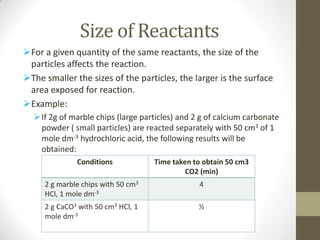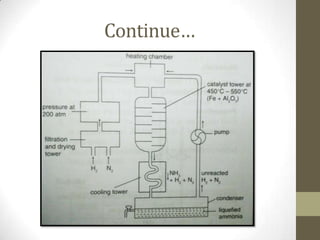Rate of reaction2
- 2. In this chapter, you will learn to: Analyse the rate of reaction. Synthesise factors affecting the rate of reaction. Synthesise ideas on the collison theory Learn about practising scientific knowledge to enhance quality of life.
- 3. 1.2 SYNTHESISE FACTORS AFFECTING THE RATE OF REACTION
- 4. LEARNING OUTCOMES Give examples of reactions that are affected by size of reactant, concentration, temperature, and catalyst. Explain how each factor affects the rate of reaction. Describe how factors affecting the rate of reaction are applied in daily life and in industrial processes. Solve problems involving factors affecting rate of reaction.
- 5. INTRODUCTION The rate of reaction is affected by the following factors: The size of reactants (or surface area) Concentration of reactants Temperature Catalyst Pressure
- 6. Size of Reactants For a given quantity of the same reactants, the size of the particles affects the reaction. The smaller the sizes of the particles, the larger is the surface area exposed for reaction. Example: If 2g of marble chips (large particles) and 2 g of calcium carbonate powder ( small particles) are reacted separately with 50 cm3 of 1 mole dm-3 hydrochloric acid, the following results will be obtained: Conditions Time taken to obtain 50 cm3 CO2 (min) 2 g marble chips with 50 cm3 4 HCl, 1 mole dm-3 2 g CaCO3 with 50 cm3 HCl, 1 ½ mole dm-3
- 7. Concentration of Reactants If 2 g of marble chips are reacted separately with dilute hydrochloric acid of two different strengths, the following results will be obtained: Conditions Time taken to obtain 50 cm3 CO2 (s) 2 g marble chips with 50 cm3 90 HCl, 1 mole dm-3 2 g marble chips with 50 cm3 45 HCl, 2 mole dm-3 The higher the concentration of a reactant, the higher is the rate of that reaction.
- 8. Temperature The rate of reaction increases when the temperature at which the reaction is taking place is increased. Example: Conditions Time taken to obtain 50 cm3 CO2 (min) 2 g marble chips with 50 cm3 3 HCl, 1 mole dm-3 at 27 oC 2 g marble chips with 50 cm3 2 HCl, 1 mole dm-3 at 35 oC
- 9. Catalyst Catalyst is a substance which causes a change in the rate of reaction without itself undergoing a chemical change at the end of the reaction. Example: Hydrogen peroxide, H2O2, does not decompose at room conditions, but in the presence of a catalyst, it decomposes into water and oxygen. The catalyst used is manganese (IV) oxide. A catalyst can either hasten or slow down a reaction. A catalyst which quickens (Hastens) a reaction is called a positive catalyst or promoter, while a catalyst which slow down a reaction is called a negative catalyst of inhibitor.
- 10. Continue… Characteristics of a catalyst include the following: A catalyst does not undergo any chemical change at the end of the reaction. The quantity and chemical composition of the catalyst remain the same at the end of the reaction. However, the catalyst can undergo a physical change during the reaction. For example, coarse manganese(IV) oxide change to the powdery form at end of the decomposition of potassium chlorate(V). Only a small quantity of catalyst is needed to change a rate of reaction but a larger quantity of catalyst can speed up the reaction and therefore increase the rate of reaction. A catalyst only changes the rate of reaction but not the quantity of products. The product produced in the reaction will not increase by the addition of a catalyst. The efficiency of a catalyst is reduced if impurities are present in it.
- 11. Continue… Some catalysts used in industrial processes are as follows: Process Reaction Catalyst Contact process To produce sulphur trioxide in the Vanadium manufacture of sulphuric acid. pentoxide V2O5 Haber process To manufacture ammonia Iron Fe Ostwald process To produce nitrogen monoxide in Platinum the manufacture of nitric acid Pt Hydrogenation of Vegetable oils are converted to Nickel margarine margarine by reaction with Ni hydrogen
- 12. Pressure Pressure can affect the rate of reaction only if it involves gases. The rate of reaction of solids and liquids are not effected by changes in pressure. A higher pressure can increase the rate of reaction. Example: Haber process Nitrogen and hydrogen combine to form ammonia when heated, but at low pressure, the reaction very slow. At a pressure of 250 atm, the rate of reaction is higher.
- 13. Continue…
- 14. Assignment Group 1 To investigate the effect of the size of the reactant on the rate of reaction. Your presentation should include the following aspect: Aim All the variables Hypothesis List of substances and apparatus Procedure Tabulation of data Discussion Conclusion
- 15. Assignment Group 2 To investigate the effect of concentration on the rate of reaction. Your presentation should include the following aspect: Aim All the variables Hypothesis List of substances and apparatus Procedure Tabulation of data Discussion Conclusion
- 16. Assignment Group 3 To investigate the effect of temperature on the rate of reaction. Your presentation should include the following aspect: Aim All the variables Hypothesis List of substances and apparatus Procedure Tabulation of data Discussion Conclusion
- 17. Assignment Group 4 To investigate the effect of catalyst on the rate of reaction. Your presentation should include the following aspect: Aim All the variables Hypothesis List of substances and apparatus Procedure Tabulation of data Discussion Conclusion
- 18. Assignment Group 5 Solve the following problem: Volume (cm3) 100 Time (s)
- 19. Continue… 1 g of calcium carbonate powder in excess is added to 50 cm3 of 0.1 mole/dm3 hydrochloric acid. The volume of gas produced is recorded at fixed points of time. A graph, showing volume against time as given in figure above is obtained. The experiment is repeated, using the same quantity of calcium carbonate and 50cm3 of 0.3 mole/dm3 hydrochloric acid. Calculate the maximum volume of gas that is produced. Draw the graph of volume against time on the same axes of the earlier experiment.


















